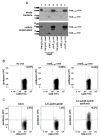CD8(+) T cells specific to a single Yersinia pseudotuberculosis epitope restrict bacterial replication in the liver but fail to provide sterilizing immunity
- PMID: 27268148
- PMCID: PMC4957522
- DOI: 10.1016/j.meegid.2016.06.008
CD8(+) T cells specific to a single Yersinia pseudotuberculosis epitope restrict bacterial replication in the liver but fail to provide sterilizing immunity
Abstract
CD8(+) T cells use contact-dependent cytolysis of target cells to protect the host against intracellular pathogens. We have previously shown that CD8(+) T cells and perforin are required to protect against the extracellular pathogen Yersinia pseudotuberculosis. Here we establish an experimental system where CD8(+) T cells specific to a single model antigen are the only memory response present at time of challenge. Using mice immunized with a vaccine strain of Listeria monocytogenes that expresses secreted ovalbumin (Lm-OVA), we show that OVA-specific CD8(+) T cells are generated and provide limited protection against challenge with virulent OVA(+)Y. pseudotuberculosis. Perforin expression by OVA-specific CD8(+) T cells was required, as Lm-OVA-immunized perforin-deficient mice showed higher bacterial burden as compared to Lm-OVA-immunized perforin-sufficient mice. Surprisingly, antigen-specific T cell protection waned over time, as Lm-OVA-immune mice eventually succumbed to Yersinia infection. Kinetic analysis of infection in mice with and without OVA-specific CD8(+) T cells revealed that bacterial numbers increased sharply in OVA-naïve mice until death, while OVA-immune mice held bacterial burden to a lower level throughout the duration of illness until death. Clonal analysis of bacterial populations in OVA-naïve and OVA-immune mice at distinct time points revealed equivalent and severe bottle-neck effects for bacteria in both sets of mice immediately after intravenous challenge, demonstrating a dominant role for other aspects of the immune system regardless of CD8(+) T cell status. These studies indicate that CD8(+) T cells against a single antigen can restrict Y. pseudotuberculosis colonization in a perforin-dependent manner, but ultimately are insufficient in their ability to provide sterilizing immunity and protect against death.
Keywords: Bottle-neck; CD8(+) T cells; Ovalbumin; Perforin; Yersinia pseudotuberculosis; YopE.
Copyright © 2016 Elsevier B.V. All rights reserved.
Figures




Similar articles
-
YopE specific CD8+ T cells provide protection against systemic and mucosal Yersinia pseudotuberculosis infection.PLoS One. 2017 Feb 16;12(2):e0172314. doi: 10.1371/journal.pone.0172314. eCollection 2017. PLoS One. 2017. PMID: 28207901 Free PMC article.
-
CD8(+) T cells restrict Yersinia pseudotuberculosis infection: bypass of anti-phagocytosis by targeting antigen-presenting cells.PLoS Pathog. 2009 Sep;5(9):e1000573. doi: 10.1371/journal.ppat.1000573. Epub 2009 Sep 4. PLoS Pathog. 2009. PMID: 19730693 Free PMC article.
-
A protective epitope in type III effector YopE is a major CD8 T cell antigen during primary infection with Yersinia pseudotuberculosis.Infect Immun. 2012 Jan;80(1):206-14. doi: 10.1128/IAI.05971-11. Epub 2011 Nov 7. Infect Immun. 2012. PMID: 22064714 Free PMC article.
-
A knockout approach to understanding CD8+ cell effector mechanisms in adaptive immunity to Listeria monocytogenes.Immunobiology. 1999 Dec;201(2):196-204. doi: 10.1016/S0171-2985(99)80059-X. Immunobiology. 1999. PMID: 10631568 Review.
-
CD8+ T-cell-mediated response to Listeria monocytogenes taken up in the liver and replicating within hepatocytes.Immunol Rev. 2000 Apr;174:112-22. doi: 10.1034/j.1600-0528.2002.017405.x. Immunol Rev. 2000. PMID: 10807511 Review.
Cited by
-
Cross-Talk Between Antigen Presenting Cells and T Cells Impacts Intestinal Homeostasis, Bacterial Infections, and Tumorigenesis.Front Immunol. 2019 Mar 6;10:360. doi: 10.3389/fimmu.2019.00360. eCollection 2019. Front Immunol. 2019. PMID: 30894857 Free PMC article. Review.
-
Checkpoint blockade inhibitors enhances the effectiveness of a Listeria monocytogenes-based melanoma vaccine.Oncotarget. 2020 Feb 18;11(7):740-754. doi: 10.18632/oncotarget.27490. eCollection 2020 Feb 18. Oncotarget. 2020. PMID: 32133048 Free PMC article.
-
YopE specific CD8+ T cells provide protection against systemic and mucosal Yersinia pseudotuberculosis infection.PLoS One. 2017 Feb 16;12(2):e0172314. doi: 10.1371/journal.pone.0172314. eCollection 2017. PLoS One. 2017. PMID: 28207901 Free PMC article.
References
Publication types
MeSH terms
Substances
Grants and funding
LinkOut - more resources
Full Text Sources
Other Literature Sources
Research Materials

